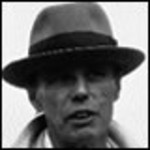Joseph Beuys
Joseph Beuys (Krefeld, 1921 - Düsseldorf, 1986) is one of the key figures of German post-war art. During his youth, Beuys manifested great interest for science and art, choosing a career in medicine, which he had to abandon in 1940, when he voluntarily enrolled in the army as a war pilot. During the war he was seriously wounded several times, and at the end of it he was held as a British prisoner-of-war for several months. These experiences profoundly influenced his art. On his return from the war in 1945, Beuys abandoned his plans for a career in medicine, and he enrolled in the Düsseldorf Art Academy to study sculpture. He graduated in 1952, and in the years to follow he focused on drawing and reading, ranging from philosophy, science, poetry, literature and the occult. During the 60, Düsseldorf consolidated as an important centre for contemporary art, and Beuys became acquainted with the experimental work of artists like Nam June Paik and the
Fluxus group. Their public performances acted as catalysers for Beuys'
actions and for his ideas on how art can play a more important role in society. As the century came to a close, his compromise with political reform increased, and he became involved in the creation of several activist groups. His charismatic presence, his public calls for all kinds of reforms and his unconventional artistic style (incorporating ritual movements and sounds, and materials such as fat, felt, earth, honey, blood and even dead animals) gave him great notoriety during this period. While he continued to use debate, discussion and teaching as part of his extended definition of art, Beuys continued to make objects, installations, multiples and performances. His international reputation grew after the 1979 retrospective at the New York Guggenheim, and he lived the last years of his life in a frantic rhythm, participating in dozens of exhibitions and travelling on behalf of these events.




